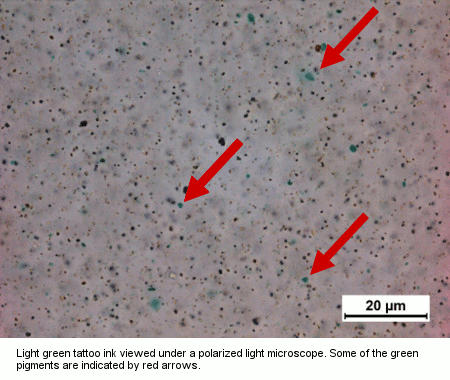Mislabeled Products: Tattoo Inks

Do the contents of a product actually match its label? Does a formulation contain undeclared ingredients?
In one instance, tattoo inks from a variety of manufacturers were submitted to Microtrace for characterization of their pigment formulations. Observation of the samples by oil immersion polarized light microscopy provided an initial indication of the number of pigments present and the general prevalence of each. Targeting individual pigments by confocal Raman microspectroscopy allowed for spectra from discrete pigment particles to be obtained and identified. Further microscopical observations, additional microanalytical characterization, and our pigment reference collection were used to assist with the interpretation of the spectroscopic data. This allowed us to confirm that both major and minor pigments in the tattoo inks were identified.
Finally, the identities of the analyzed pigments were compared to the formulations provided on the product labels. While many of the labels matched the list of actual identified pigments, there were exceptions in which the identified pigments were either not listed on the label or varied from the pigments listed on the label.
The microanalytical characterization of product formulations can be used to confirm that a product conforms to its specifications, ensure regulatory compliance, compare products from alternate supplies, detect counterfeit products, and identify the presence of unintended ingredients and contaminants. This approach is applicable to products and ingredients of virtually any type, from consumer products such as cosmetics and pharmaceuticals, to food and nutritional supplements, to components of more complex formulations.
How May We Help You?
Contact usto discuss your project in more detail.







